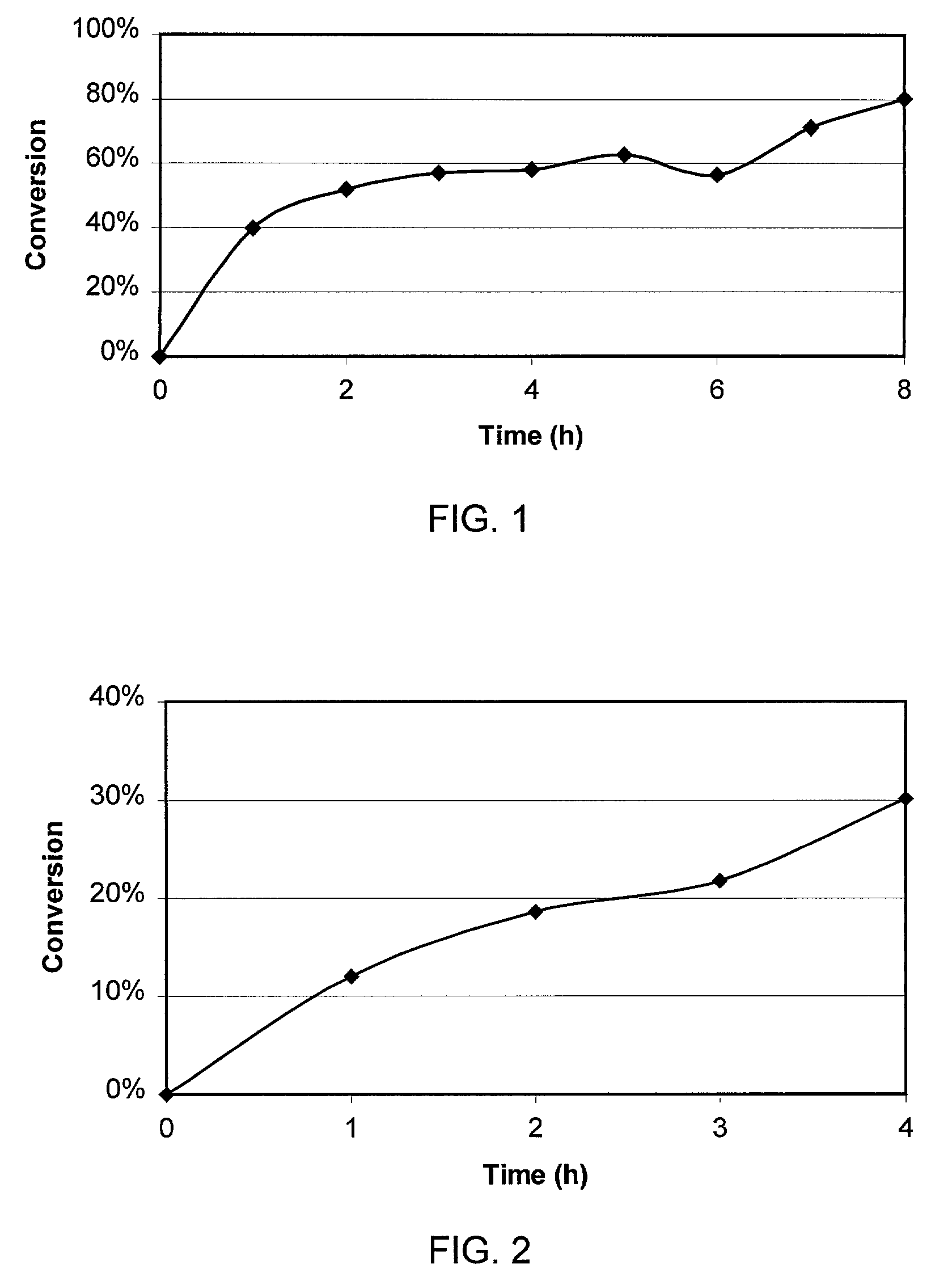Process for producing sterol or stanol esters by enzymatic transesterification in solvent and water free media
a technology of stanol esters and enzymatic transesterification, which is applied in the direction of steroids, hydrolases, organic chemistry, etc., can solve the problems of many setbacks in the disclosed process, and the inability to elaborate nutraceutical food ingredients, etc., and achieves the effect of high efficiency and suitable nutraceutical us
- Summary
- Abstract
- Description
- Claims
- Application Information
AI Technical Summary
Benefits of technology
Problems solved by technology
Method used
Image
Examples
example 1
Preparation of Ethyl Ester of Fatty Acids of Sunflower Oil
[0022]10 1 technical grade ethanol, 313 g concentrated sulfuric acid and 10.3 Kg commercial sunflower oil fatty acids were loaded under slight nitrogen flux in a 40 1 stainless steel agitated reactor provided with electrical heater, refrigeration coil, loading funnel, column, condenser, Dean-Stark separator, bottom valve, nitrogen injector and vacuum connection for distillation at reduced pressure. Nitrogen flux was interrupted and the mixture was refluxed at 77° C. for 10 hours with periodically monitoring the acid number. When the acid number reached 6.4, ethanol was distilled off until 90% of the initial amount of ethanol was recovered. The mixture was cooled to 60° C. and diluted with 7 kg of hexane. Remaining acidity was neutralized with 8 kg of an aqueous solution of technical grade sodium carbonate at 10%. The aqueous phase was eliminated and the organic phase was washed three times with 1 Kg of a water:ethanol mixture...
example 2
Transesterification of a Mixture of Sterols and Stanols
[0023]A reacting mixture of the composition shown in Table 1 (initial composition at time=0) was formed by mixing 1000 ml of ethyl esters of fatty acids of sunflower oil, 180 g of a mixture of sterols and stanols (wood alcohols) and 10 g of lipase of Pseudomonas stutzeri (MEITO SANGYO CO., LTD. Lipase-TL) with lipolytic activity of 20,000 units per gram, were loaded in a 2000-ml SCHOTT-DURAN round bottom, flat flange reaction vessel with flat flange lid provided with 4 standard ground necks. The reactor was partially immersed in a water bath at 60° C. A reactor outlet was connected to a vacuum pump (TRIVAC B D 16B) keeping the pressure at 2 mbar in the reactor during the reaction. Stirring was made by means of a magnetic stirrer. The agitation was stopped every hour to allow for the taking of a sample, the sample was centrifuged at 10,000 g for 15 minutes to remove lipase, and the sterol and stanol content of the centrifuged sam...
example 3
Transesterification of Wood Alcohols
[0029]A reacting mixture, whose composition is shown in Table 2, was formed by mixing 100 ml of ethyl esters of fatty acids of tall oil, prepared as described in Example 1, were mixed in the reactor of Example 2 with 10 g of wood alcohol and 0.5 g of lipase of Pseudomonas (Burkholderia) capacia (MEITO SANGYO CO., LTD Lipase-SL) with lipolytic activity of 36,000 units per gram. Reaction temperature was 70° C. and the pressure 0.8 mbar. Extraction of samples and analysis were performed as described in Example 2. Table 2 shows the variation of the composition of the reacted mixture with time and FIG. 2 shows the variation at different reaction times of the conversion in the reacted mixture of wood alcohols to steryl and stanyl esters.
[0030]
TABLE 2Variation of the composition of the reacted mixtureat different reaction times in Example 2Time (h)01234Component% in weight of component of the mixtureCampesterol0.760.670.630.600.54Campestanol0.060.050.040...
PUM
| Property | Measurement | Unit |
|---|---|---|
| pressure | aaaaa | aaaaa |
| temperature | aaaaa | aaaaa |
| temperatures | aaaaa | aaaaa |
Abstract
Description
Claims
Application Information
 Login to View More
Login to View More - R&D
- Intellectual Property
- Life Sciences
- Materials
- Tech Scout
- Unparalleled Data Quality
- Higher Quality Content
- 60% Fewer Hallucinations
Browse by: Latest US Patents, China's latest patents, Technical Efficacy Thesaurus, Application Domain, Technology Topic, Popular Technical Reports.
© 2025 PatSnap. All rights reserved.Legal|Privacy policy|Modern Slavery Act Transparency Statement|Sitemap|About US| Contact US: help@patsnap.com

